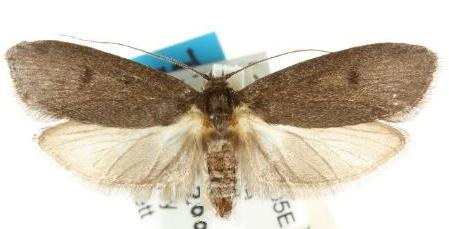
| CHEZALA GROUP OECOPHORINAE, OECOPHORIDAE, GELECHIOIDEA | (donherbisonevans@yahoo.com) and Stella Crossley |

(Photo: courtesy of CSIRO/BIO Photography Group,
Centre for Biodiversity Genomics,
University of Guelph)

| CHEZALA GROUP OECOPHORINAE, OECOPHORIDAE, GELECHIOIDEA | (donherbisonevans@yahoo.com) and Stella Crossley |

(Photo: courtesy of CSIRO/BIO Photography Group,
Centre for Biodiversity Genomics,
University of Guelph)
These Caterpillars appear to live in the nests of only one species of parrot:
which nest in chambers in termite mounds. The Caterpillars live in a silk cocoon at the bottom of the nest feeding on the droppings of the nestlings, thus keeping the nest clean. The moths have an annual cycle synchronising with that of the parrots.
The adult moths have brown forewings, each with a dark mark near the middle. The hindwings are white each shading to brown at the tornus.
The moths are very similar to those of the related species Trisyntopa scatophaga.
The moths are found in
Further reading :
Stuart J. N. Cooney, Penny D. Olsen, and Stephen T. Garnett,
Ecology of the coprophagous moth Trisyntopa neossophila Edwards
(Lepidoptera: Oecophoridae)
Australian Journal of Entomology,
Volume 48, Issue 2 (May 2009), pp. 97–101,
Edward D. Edwards, Stuart J. N. Cooney, Penny D. Olsen, and Stephen T. Garnett,
A new species of Trisyntopa Lower (Lepidoptera: Oecophoridae)
associated with the nests of the hooded parrot
(Psephotus dissimilis, Psittacidae) in the Northern Territory
Australian Journal of Entomology,
Volume 46 (2007), pp. 276–280.
Penny Olsen,
Glimpses of Paradise: The Quest for the Beautiful Parrakeet,
National Library of Australia, 2007.
 caterpillar |  butterflies |  Lepidoptera |  moths |  caterpillar |
(written 14 October 2013, updated 6 March 2017)